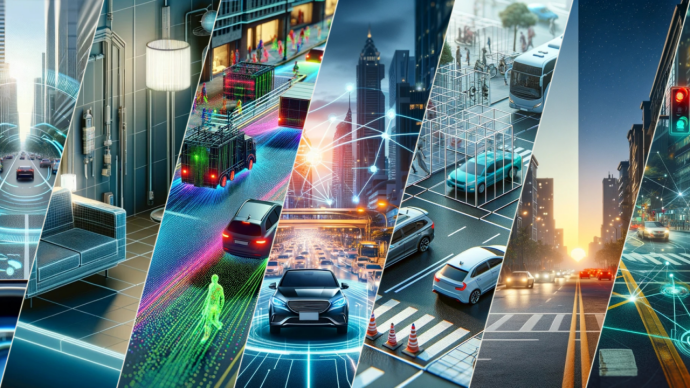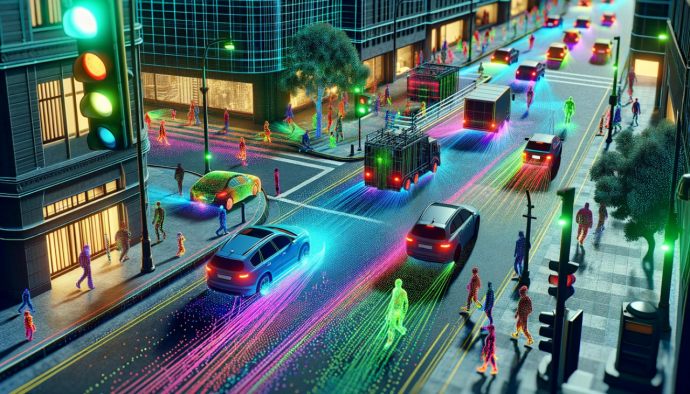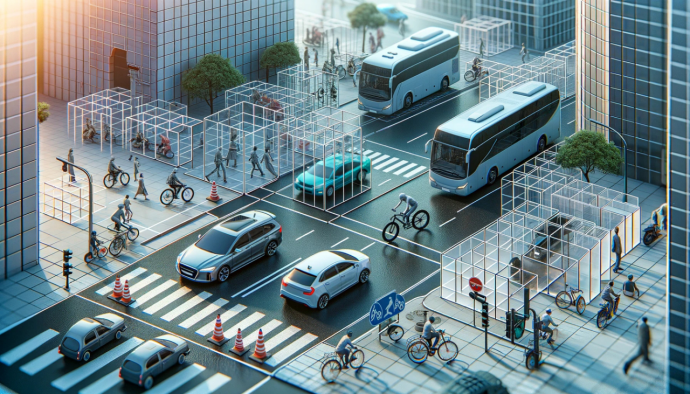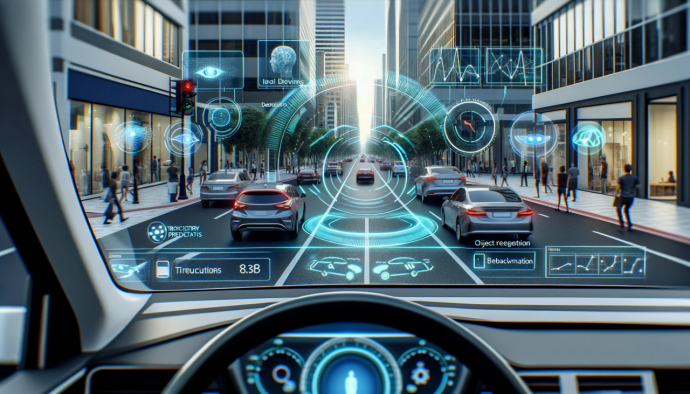2024 International Autonomous Driving Challenge Officially Starts

- New competition topics: seven tracks, novel competition topics, comprehensive coverage of the latest and hottest topics in related fields, fully exploring the application of large models in the vertical fields of autonomous driving and embodied intelligence applications in.
- High prize money: The total prize pool exceeds 120,000 US dollars, and the maximum prize money for a single track can reach 27,000 US dollars. According to incomplete statistics, the reward amount is the highest among the 100 forums in CVPR 2024.
- Emphasis on originality: strengthen basic research and exploration, and adhere to the four aspects. Originality and scientific research value are used as the main measurement indicators, and rankings are not solely based on performance. Comprehensive ranking is carried out by combining original solutions and performance indicators.
On March 1, 2024, the 2024 International Autonomous Driving Challenge was officially launched. This challenge is hosted by Shanghai Artificial Intelligence Laboratory and co-organized by a number of domestic and foreign institutions. A number of well-known experts and scholars at home and abroad form the competition guidance and awards committee. This competition aims to provide an in-depth exploration of the tasks and challenges faced by autonomous systems and provide a stage for global participants to showcase technology and innovation. In this competition, we do not set too many restrictions on the participants. For example, multiple teams from the same organization are allowed to participate, all public data sets and pre-training weights are allowed to be used, and one team is allowed to win multiple awards at the same time. There are seven tracks in this competition, and the winner has the opportunity to receive a reward of up to 27,000 US dollars, and also has the opportunity to be invited to submit articles in top international journals. We have also prepared detailed competition guidelines and benchmark models for each track, which can be accessed by clicking on the corresponding link for each track.
Official website of the competition:
https://opendrivelab.com/challenge2024
Main activity:
CVPR 2024 Forum-Workshop on Foundation Models for Autonomous Systems (Seattle, USA)
Related events:
- Late April: The 3rd China 3D Vision Conference ( China3DV 2024)
- http://www.csig3dv.net/2024/competition.html
- Mid-June: Offline activities (Beijing/Shanghai)
Introduction to the competition topicEnd-to-end automatic driving
Due to the size of the previous data set Limited, inconsistent open- and closed-loop metrics make it difficult to benchmark sensorimotor-driven strategies using real data. In this track, large-scale data will be used to bridge the gap between the two evaluation paradigms, and through BEV abstract modeling in a short time series, efficient open-loop evaluation will be achieved while better aligning with closed-loop evaluation.
- Track information: https://www.php.cn/link/492f948808daf55a3f9e7ddd3694f546#end_to_end_driving_at_scale
- Data volume: about 2T
- Test server: https: //huggingface.co/spaces/AGC2024-P/e2e-driving-2024

World Model
As an abstract spatiotemporal representation of reality, The world model can predict the future state based on the observed current state, and learning the world model will promote the performance of the basic model to a new level. The model needs to predict the point cloud at future moments with only visual input to prove its ability to predict the world.
- Track information: https://www.php.cn/link/492f948808daf55a3f9e7ddd3694f546#predictive_world_model
- Data volume: about 2T
- Reference training time: sample Data, 8 cards A100, 3 days
- Test server: https://huggingface.co/spaces/AGC2024-P/predictive-world-model-2024

Occupation grid and motion estimation
Three-dimensional boxes are often insufficient to describe general objects. Inspired by the concept of robotics, perceptual representation can be described as the occupation of a gridded three-dimensional space. predict. In this track, contestants must not only provide a raster representation of the three-dimensional space, but also predict the movement of the raster.
- Track information: https://www.php.cn/link/492f948808daf55a3f9e7ddd3694f546#occupancy_and_flow
- Autonomous Driving Challenge @China3DV: https://huggingface.co/spaces /China3DV-S/occupancy-and-flow-2024
- Data volume: about 70GB
- Reference training time: 8 cards 3090, 2 days
- Test server: https: //huggingface.co/spaces/AGC2024-S/occupancy-and-flow-2024

Embodied multi-modal three-dimensional visual positioning
Compared with driving scenes, indoor embodied three-dimensional perception systems face multi-modal input including language instructions, more complex semantic understanding, more diverse object categories and orientations, and very different perception spaces. and needs. Based on this, the competition constructed a first-perspective multi-modal full-scene three-dimensional perception toolkit EmbodiedScan. The goal of this task is to detect the category of the target object and its oriented three-dimensional box given a verbal description of a specific object.
- Track information: https://www.php.cn/link/492f948808daf55a3f9e7ddd3694f546#multiview_3d_visual_grounding
- Data volume: about 1.5T
- Reference training time: Sample data 8 cards A100 0.5 days, full data 8 cards A100 3 days
- Test server: https://huggingface.co/spaces/AGC2024/visual-grounding-2024

CARLA Self-Driving Challenge
The CARLA Self-Driving Challenge requires vehicles to travel through a set of pre-defined routes. Vehicle driving routes involve complex situations, such as highways, urban areas, residential areas, and rural environments. They also include sunlight, sunset, night, rain, fog, and other light and weather conditions, which provide the possibility for closed-loop evaluation of autonomous driving systems.
- Track information: https://www.php.cn/link/492f948808daf55a3f9e7ddd3694f546#carla
- Test server: https://eval.ai/web/challenges/challenge -page/2098/overview

Application of large language model in autonomous driving
By introducing language information, The DriveLM data set connects large language models with autonomous driving systems, and ultimately makes decisions by introducing language reasoning capabilities to ensure the interpretability of planning. Taking multi-view images as input information, the model must answer various questions related to driving.
- Track information: https://www.php.cn/link/492f948808daf55a3f9e7ddd3694f546#driving_with_language
- Data volume: training set 4072 frames, test set 799 frames, each frame is about 90 question and answer pairs
- Reference training time: 8 cards V100, 1 day
- Test server: https://huggingface.co/spaces/AGC2024/driving-with-language-2024

Drive without a map
In the absence of high-definition maps, self-driving cars require a high level of scene understanding, and this track is designed to explore The limits of scenario reasoning capabilities. Taking multi-view images and standard-definition maps as input information, the neural network must not only output the perception results of lanes and traffic elements, but also output the topological relationships between lanes and between lanes and traffic elements.
- Track information: https://www.php.cn/link/492f948808daf55a3f9e7ddd3694f546#mapless_driving
- Autonomous Driving Challenge @China3DV: https://huggingface.co/spaces /China3DV/mapless-driving-2024
- Data volume: about 200G
- Reference training time: 8 cards V100, 1 day
- Test server: https://huggingface. co/spaces/AGC2024/mapless-driving-2024

Schedule
The following times are all Beijing time, please refer to the official website of the competition for details .
- From now on - June 1, 2024: Registration
- March 1, 2024: The competition officially begins
- March 25, 2024: Test server is open
- June 1, 2024: Test server is closed
- June 18, 2024: Competition results announced
Guidance and Awards Committee
Sorted by name strokes; the list is being updated continuously.
Qiao Yu |
Shanghai Artificial Intelligence Laboratory |
Leader Scientist, Assistant to the Director |
Liu Qingshan |
Nanjing University of Posts and Telecommunications |
vice-president |
| ##杨小康 | Shanghai Jiao Tong University | Executive Dean of the Institute of Artificial Intelligence |
| Li Shengbo | Tsinghua University | Secretary of the Party Committee of the Vehicle College, national high-level leading talent, professor |
Zhang Yaqin |
Tsinghua University |
Foreign academician of the Chinese Academy of Engineering, President of the Institute of Intelligent Industry, Chair Professor |
Chen Baoquan |
Peking University |
Deputy Dean of the School of Intelligence, Boya Distinguished Professor |
| Xia Huaxia |
Meituan |
Chief Scientist, Vice President |
| ##高新波 | Chongqing University of Posts and Telecommunications | Deputy Secretary of the Party Committee, President, Professor |
| Xue Jianru | Xi'an Jiaotong University | Professor |
https://opendrivelab.com/challenge2024
WeChat communication Group 
Registration link
workshop-e2e-ad@googlegroups.com
The above is the detailed content of 2024 International Autonomous Driving Challenge Officially Starts. For more information, please follow other related articles on the PHP Chinese website!

Hot AI Tools

Undresser.AI Undress
AI-powered app for creating realistic nude photos

AI Clothes Remover
Online AI tool for removing clothes from photos.

Undress AI Tool
Undress images for free

Clothoff.io
AI clothes remover

AI Hentai Generator
Generate AI Hentai for free.

Hot Article

Hot Tools

Notepad++7.3.1
Easy-to-use and free code editor

SublimeText3 Chinese version
Chinese version, very easy to use

Zend Studio 13.0.1
Powerful PHP integrated development environment

Dreamweaver CS6
Visual web development tools

SublimeText3 Mac version
God-level code editing software (SublimeText3)

Hot Topics
 DeepMind robot plays table tennis, and its forehand and backhand slip into the air, completely defeating human beginners
Aug 09, 2024 pm 04:01 PM
DeepMind robot plays table tennis, and its forehand and backhand slip into the air, completely defeating human beginners
Aug 09, 2024 pm 04:01 PM
But maybe he can’t defeat the old man in the park? The Paris Olympic Games are in full swing, and table tennis has attracted much attention. At the same time, robots have also made new breakthroughs in playing table tennis. Just now, DeepMind proposed the first learning robot agent that can reach the level of human amateur players in competitive table tennis. Paper address: https://arxiv.org/pdf/2408.03906 How good is the DeepMind robot at playing table tennis? Probably on par with human amateur players: both forehand and backhand: the opponent uses a variety of playing styles, and the robot can also withstand: receiving serves with different spins: However, the intensity of the game does not seem to be as intense as the old man in the park. For robots, table tennis
 Claude has become lazy too! Netizen: Learn to give yourself a holiday
Sep 02, 2024 pm 01:56 PM
Claude has become lazy too! Netizen: Learn to give yourself a holiday
Sep 02, 2024 pm 01:56 PM
The start of school is about to begin, and it’s not just the students who are about to start the new semester who should take care of themselves, but also the large AI models. Some time ago, Reddit was filled with netizens complaining that Claude was getting lazy. "Its level has dropped a lot, it often pauses, and even the output becomes very short. In the first week of release, it could translate a full 4-page document at once, but now it can't even output half a page!" https:// www.reddit.com/r/ClaudeAI/comments/1by8rw8/something_just_feels_wrong_with_claude_in_the/ in a post titled "Totally disappointed with Claude", full of
 The first mechanical claw! Yuanluobao appeared at the 2024 World Robot Conference and released the first chess robot that can enter the home
Aug 21, 2024 pm 07:33 PM
The first mechanical claw! Yuanluobao appeared at the 2024 World Robot Conference and released the first chess robot that can enter the home
Aug 21, 2024 pm 07:33 PM
On August 21, the 2024 World Robot Conference was grandly held in Beijing. SenseTime's home robot brand "Yuanluobot SenseRobot" has unveiled its entire family of products, and recently released the Yuanluobot AI chess-playing robot - Chess Professional Edition (hereinafter referred to as "Yuanluobot SenseRobot"), becoming the world's first A chess robot for the home. As the third chess-playing robot product of Yuanluobo, the new Guoxiang robot has undergone a large number of special technical upgrades and innovations in AI and engineering machinery. For the first time, it has realized the ability to pick up three-dimensional chess pieces through mechanical claws on a home robot, and perform human-machine Functions such as chess playing, everyone playing chess, notation review, etc.
 At the World Robot Conference, this domestic robot carrying 'the hope of future elderly care' was surrounded
Aug 22, 2024 pm 10:35 PM
At the World Robot Conference, this domestic robot carrying 'the hope of future elderly care' was surrounded
Aug 22, 2024 pm 10:35 PM
At the World Robot Conference being held in Beijing, the display of humanoid robots has become the absolute focus of the scene. At the Stardust Intelligent booth, the AI robot assistant S1 performed three major performances of dulcimer, martial arts, and calligraphy in one exhibition area, capable of both literary and martial arts. , attracted a large number of professional audiences and media. The elegant playing on the elastic strings allows the S1 to demonstrate fine operation and absolute control with speed, strength and precision. CCTV News conducted a special report on the imitation learning and intelligent control behind "Calligraphy". Company founder Lai Jie explained that behind the silky movements, the hardware side pursues the best force control and the most human-like body indicators (speed, load) etc.), but on the AI side, the real movement data of people is collected, allowing the robot to become stronger when it encounters a strong situation and learn to evolve quickly. And agile
 Li Feifei's team proposed ReKep to give robots spatial intelligence and integrate GPT-4o
Sep 03, 2024 pm 05:18 PM
Li Feifei's team proposed ReKep to give robots spatial intelligence and integrate GPT-4o
Sep 03, 2024 pm 05:18 PM
Deep integration of vision and robot learning. When two robot hands work together smoothly to fold clothes, pour tea, and pack shoes, coupled with the 1X humanoid robot NEO that has been making headlines recently, you may have a feeling: we seem to be entering the age of robots. In fact, these silky movements are the product of advanced robotic technology + exquisite frame design + multi-modal large models. We know that useful robots often require complex and exquisite interactions with the environment, and the environment can be represented as constraints in the spatial and temporal domains. For example, if you want a robot to pour tea, the robot first needs to grasp the handle of the teapot and keep it upright without spilling the tea, then move it smoothly until the mouth of the pot is aligned with the mouth of the cup, and then tilt the teapot at a certain angle. . this
 ACL 2024 Awards Announced: One of the Best Papers on Oracle Deciphering by HuaTech, GloVe Time Test Award
Aug 15, 2024 pm 04:37 PM
ACL 2024 Awards Announced: One of the Best Papers on Oracle Deciphering by HuaTech, GloVe Time Test Award
Aug 15, 2024 pm 04:37 PM
At this ACL conference, contributors have gained a lot. The six-day ACL2024 is being held in Bangkok, Thailand. ACL is the top international conference in the field of computational linguistics and natural language processing. It is organized by the International Association for Computational Linguistics and is held annually. ACL has always ranked first in academic influence in the field of NLP, and it is also a CCF-A recommended conference. This year's ACL conference is the 62nd and has received more than 400 cutting-edge works in the field of NLP. Yesterday afternoon, the conference announced the best paper and other awards. This time, there are 7 Best Paper Awards (two unpublished), 1 Best Theme Paper Award, and 35 Outstanding Paper Awards. The conference also awarded 3 Resource Paper Awards (ResourceAward) and Social Impact Award (
 Hongmeng Smart Travel S9 and full-scenario new product launch conference, a number of blockbuster new products were released together
Aug 08, 2024 am 07:02 AM
Hongmeng Smart Travel S9 and full-scenario new product launch conference, a number of blockbuster new products were released together
Aug 08, 2024 am 07:02 AM
This afternoon, Hongmeng Zhixing officially welcomed new brands and new cars. On August 6, Huawei held the Hongmeng Smart Xingxing S9 and Huawei full-scenario new product launch conference, bringing the panoramic smart flagship sedan Xiangjie S9, the new M7Pro and Huawei novaFlip, MatePad Pro 12.2 inches, the new MatePad Air, Huawei Bisheng With many new all-scenario smart products including the laser printer X1 series, FreeBuds6i, WATCHFIT3 and smart screen S5Pro, from smart travel, smart office to smart wear, Huawei continues to build a full-scenario smart ecosystem to bring consumers a smart experience of the Internet of Everything. Hongmeng Zhixing: In-depth empowerment to promote the upgrading of the smart car industry Huawei joins hands with Chinese automotive industry partners to provide
 The first large UI model in China is released! Motiff's large model creates the best assistant for designers and optimizes UI design workflow
Aug 19, 2024 pm 04:48 PM
The first large UI model in China is released! Motiff's large model creates the best assistant for designers and optimizes UI design workflow
Aug 19, 2024 pm 04:48 PM
Artificial intelligence is developing faster than you might imagine. Since GPT-4 introduced multimodal technology into the public eye, multimodal large models have entered a stage of rapid development, gradually shifting from pure model research and development to exploration and application in vertical fields, and are deeply integrated with all walks of life. In the field of interface interaction, international technology giants such as Google and Apple have invested in the research and development of large multi-modal UI models, which is regarded as the only way forward for the mobile phone AI revolution. In this context, the first large-scale UI model in China was born. On August 17, at the IXDC2024 International Experience Design Conference, Motiff, a design tool in the AI era, launched its independently developed UI multi-modal model - Motiff Model. This is the world's first UI design tool












